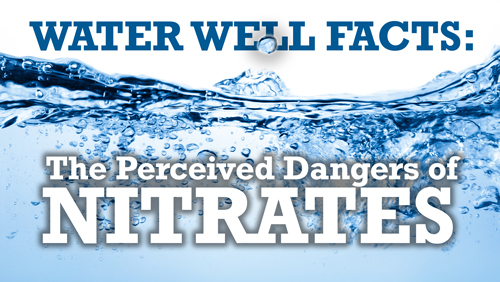The headlines are filled with residential water quality stories and consumers are more aware than ever of potential household water contamination. People with private wells, especially in the Midwest, are sensitive to the idea of nitrates and contaminants in their well water. We’d like to share some information found in a recent newsletter from the Wisconsin Water Well Association that can help you dispel some myths regarding nitrates for your water well customers.

Which contaminants find their way into well water is determined largely by the property and the geologic makeup of the area around the well. Soil and sand are excellent filters, except when presented in thin layers over fractured rock – providing very little to filter out impurities from surface water. Sand is excellent for filtering out bacteria but can’t hold on to nutrients like nitrates, and soil without significant plant roots and organic matter also allow the passage of nitrates. A comprehensive knowledge of the soil quality and geological aspects of their operation areas put well drillers and pump installers in a perfect position to educate homeowners with private wells and ease their concerns.
Nitrates have many important uses including as plant nutrients and as a food additive in processed meat. For the most part, nitrates in drinking water aren’t a concern and don’t seem to be dangerous. In fact, we need to point out that nitrates occur naturally in the food we eat and the water we drink. High levels of nitrates in water can also point to the possibility that other contaminants like pesticides and herbicides from local farms or pharmaceuticals from septic systems are also entering the water supply.
Testing is the only way to know if nitrates are present and if they are within federal standards for drinking water, established at a maximum of 10 milligrams per liter. While testing isn’t required in every state, it’s a good rule of thumb to perform a test when drilling a new well as well as when installing, replacing, or repairing a pump. If there are nitrate concerns, it’s also recommended to do further testing for pesticides, pharmaceuticals, and herbicides. Groundwater quality is always changing, especially with the change of the seasons, so yearly testing can further help ensure safety and quality.
There are many possible causes for high nitrates in the groundwater source. Septic systems, fertilization of golf courses, lawns, and gardens are as much to blame as ag facilities that may have manure storage and field fertilization. The important thing to remember is that with regular testing and education, water quality can be measured and maintained.
If you find a nitrate level concern, there are some fairly quick actions you can take to rectify it. One way to address the issue is to look at drilling deeper or moving the well to a different location, although this is not always an ideal solution. Another option would be establishing a reverse osmosis system. These filtration systems offer the best option for peace of mind by reducing herbicide, pesticide, and pharmaceutical levels and nitrate levels by as much as 80 percent.
Urban sprawl leads to more housing construction in rural areas, increasing the push for green lawns and higher farm production. In turn, this increases the potential for groundwater contamination. But through awareness, education, and regular testing, homeowners can trust their private wells to be safe for their families.



